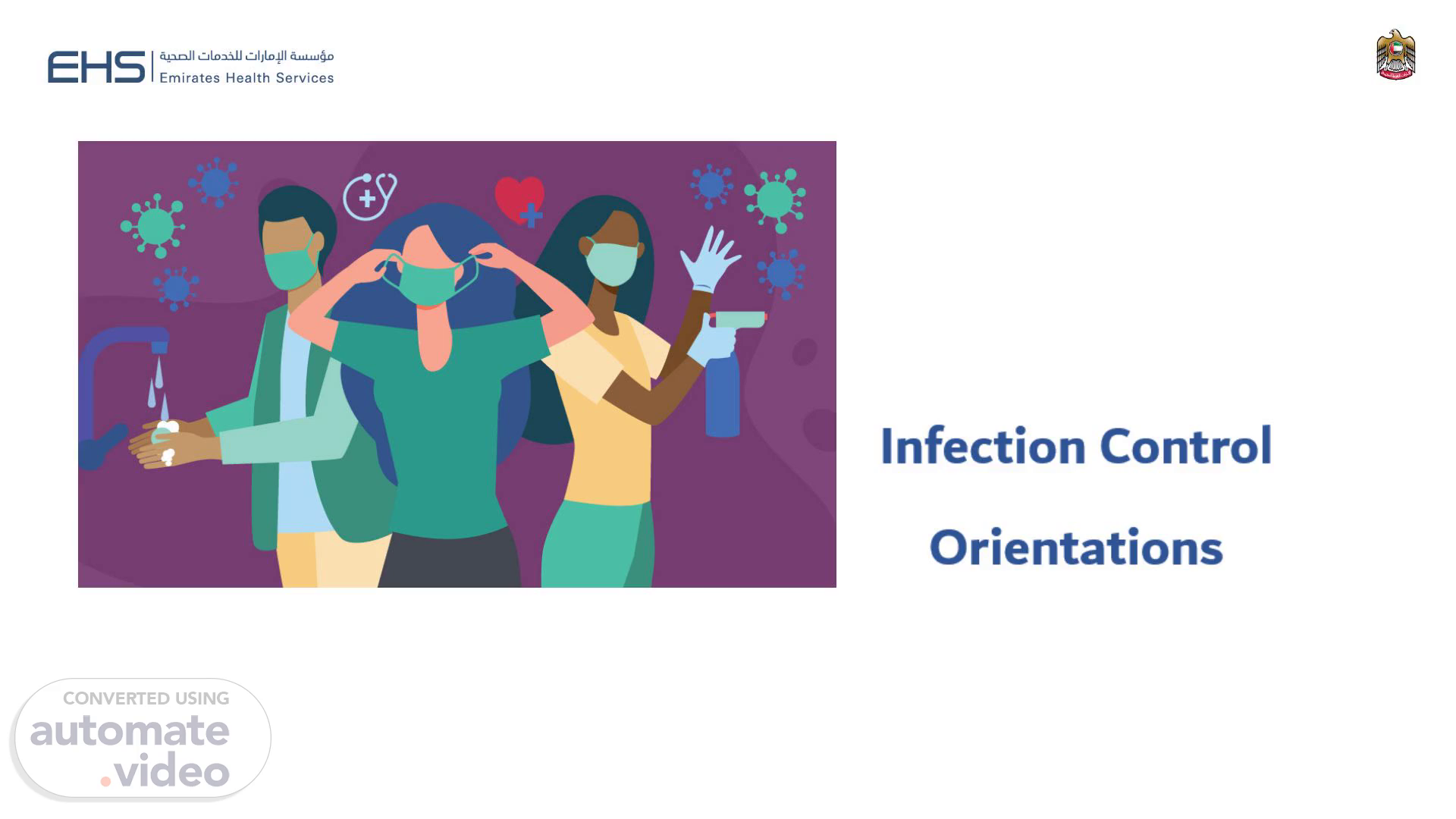
PowerPoint Presentation
Scene 1 (0s)
[Audio] Infection control orientations Presented by Asma Alzaabi Infection control practioner.
Scene 2 (12s)
[Audio] Infection control orientation Modules includes Standard/ Universal Precautions , Hand Hygiene, Staff occupational health and safety including needle and sharp injuries Personal protective equipment and Waste Management.
Scene 3 (30s)
[Audio] Standard Precautions are the absolute minimum level of protection for preventing occupational exposure to blood borne pathogens and other infectious agents to ensure safety of staff, patients and others in the healthcare environment. Standard Precautions Include Hand hygiene, Use of personal protective equipment e.g., gloves, masks, eyewear , Respiratory hygiene and cough etiquette, Sharps safety (work practice controls and Sterile instruments and devices..
Scene 4 (1m 1s)
[Audio] Why is effective hand hygiene important? Washing your hands properly is one of the most important things you can do to help prevent and control the spread of many illnesses. Good hand hygiene will reduce the risk of things like flu, food poisoning and healthcare associated infections being passed from person to person. Hand hygiene should by Hand Rub or Hand Wash you can choose what you prefer There were no significant differences between using handwashing method compared to hand rub in reducing total bacterial colony on hands except if your hand visibly soiled or if you are caring for a resident who has sickness or diarrhoeal illnesses such as norovirus or Clostridioides difficile..
Scene 5 (1m 44s)
[Audio] Hand wash. undefined. Hand Wash.
Scene 6 (2m 30s)
[Audio] Hand Rub. undefined. Hand Rub.
Scene 7 (3m 13s)
[Audio] The World Health Organization (WHO) has developed an evidence-based measure of hand hygiene called the five moments of hand hygiene which refer to washing hands before touching a patient, before performing an aseptic or clean procedure, after potentials exposure to body fluids, after touching a patient, and after touching the patient surroundings..
Scene 8 (3m 36s)
[Audio] What is the order for donning PPE? Putting on Personal Protective Equipment (PPE) Perform hand hygiene before putting on PPE. The order for putting on PPE is Apron or Gown, Surgical Mask, Eye Protection (where required) and Gloves..
Scene 9 (4m 16s)
[Audio] In what order do you remove PPE? The sequence for removing PPE is intended to limit opportunities for self-contamination. Sequence of removal: (1) Gloves, (2) Face shield or goggles, (3) Gown, (4) Mask or respirator*. Perform hand hygiene after PPE removal, preferably after each step.
Scene 10 (4m 59s)
undefined. Use of personal protective equipment (e.g., gloves, masks, eyewear)..
Scene 11 (5m 59s)
[Audio] What is respiratory etiquette policy? Respiratory etiquette is a simple yet effective way to prevent illness, and is comprised of a few easy steps: Cover your cough and sneeze. Turn your head away from others and cover your mouth and nose with a tissue. If you don't have a tissue, cough or sneeze into your upper sleeve or elbow, not your hands..
Scene 12 (6m 21s)
undefined.
Scene 13 (7m 5s)
[Audio] Waste Management: Medical Waste: collect in Yellow Bio hazard bags with thickness of 100mic marked with biohazard symbol used to dispose of infectious waste. General Waste: collect in black waste bag which finally gets disposed of into the general municipality waste dispenser using designated trolley. Red bag with biohazard symbol: collect highly infectious waste and for body organ / body part, pathological waste & placenta in red/ yellow bag with biohazard symbol and ensure appropriate labelling of these items. Sharps: Ensure that all sharps are collected in sharp containers that are puncture proof and leak-proof..
Scene 14 (7m 50s)
[Audio] Sterile instruments and device Medical devices that have contact with sterile body tissues or fluids are considered critical items. These items should be sterile when used because any microbial contamination could result in disease transmission. Such items include surgical instruments, biopsy forceps, and implanted medical devices..
Scene 15 (8m 12s)
[Audio] Cleaning, Disinfection and Sterilization Critical items: object that enter normal sterile tissue or vascular system (e.g.,surgical instrument) should be sterilize Before use on each patient. Semi-critical items: that touches either mucous membranes or non-intact skin (e.g.,gastrointestinal endoscopes, endotracheal tubes, anesthesia breathing circuits, and respiratory therapy equipment); minimally required high level disinfection usingchemical disinfectant\sterilization if compatible. Non-critical items: that touch intact skin that require low-level disinfection (e, g phenols, alcohol quaternary ammonium compound) and for noncritical patient-caresurfaces (e.g., bedrails, over-the-bed table) and equipment (e.g., blood pressurecuff)..
Scene 16 (9m 9s)
[Audio] Staff occupational health and safety including needle and sharp injuries Hepatitis B antibodies screening has been done for all clinical employees . Hepatitis A & B screening has been done for the kitchen staff. Non immune staff have been revaccinated Recommended Annual vaccination such as Influenza vaccine. Any other vaccination recommended as per preventive medicine program (staff COVID-19 vaccinated) ..
Scene 17 (9m 38s)
[Audio] Management of Blood Exposures: Needlestick injuries, splashes and others: Wash the wound with copious, running water and an antiseptic agent. If an eye exposure occurs, wash with copious saline or use the eyewash kit. Report the incident immediately to the manager and Infection Control staff or designee. Complete the OVR form as per the policy. Complete the Bloodborne Pathogens exposure report form and submit to the Infection Control staff Assist the exposed and the source, if known, for blood investigations (for the source: HIV I &II antibodies, HbsAg, and Anti HCV; for the exposed: HIV I &II antibodies, HbsAg, Anti-Hbs and Anti HCV). Ensure that blood samples are sent to the lab as soon as possible and the tests are performed on an urgent basis. Follow up the lab results and take follow up measures according to the results. Arrange for any post exposure prophylaxis as required..
Scene 18 (10m 42s)
[Audio] Needle and sharp injuries Staff should report event by : OVR and Blood Bourne pathogen exposure report form As soon as they occur.
Scene 19 (11m 5s)
[Audio] Thanks. Respiratory hygiene / cough etiquette..